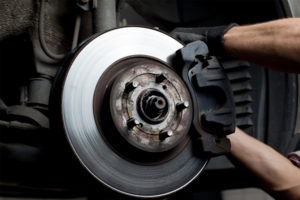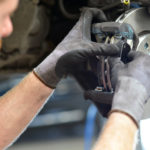It’s common knowledge that brake pads should be periodically maintained and replaced, however MANNOL UK’s team of experts have identified the most likely causes of brake pad wear so technicians and workshops can easily identify potential issues.
EVEN WEAR
Issue: The pads have approximately the same amount of friction material on both.
Cause: Proper brake function.
Solution: Replacement of the brake pads and hardware, such as abutment and anti- rattle clips, is required, as well as servicing the caliper guide pins and slides.
INNER PAD WEAR
Issue: The inboard brake shows more wear than the outboard pad.
Cause: The caliper piston doesn’t return to the rest position due to a worn seal, damage, or corrosion; it can also be caused by a problem with the master cylinder.
Solution: Take the same steps as fixing the outer pad wear as well as inspecting the hydraulic brake system and the caliper for residual pressure and guide pin hole or piston boot damage, respectively. If the pin holes or piston boot are corroded or damaged, then replacement is necessary.
OUTER PAD WEAR
Issue: The outer pad continues to ride on the rotor after the caliper releases, resulting in the outboard pad having markedly less friction material than the inboard pad.
Cause: Seizing guide pins, bushings and slides are usually the cause of the issue.
Solution: Correcting this issue is fairly straightforward and is normally rectified by servicing or replacing the guide pins, bushings, or the entire caliper, and replacing the brake pads.
TAPERED PAD WEAR
Issue: The friction material is worn in a horizontal or vertical wedge pattern.
 Cause: Improper pad installation as well as guide pin wear, or having a single guide pin or slide seizing.
Cause: Improper pad installation as well as guide pin wear, or having a single guide pin or slide seizing.
Solution: The procedure for rectifying this kind of wear is the same as correcting outer pad wear.
OVERLAPPING FRICTION MATERIAL
Issue: The top edge of the pad overlaps the top of the rotor.
Cause: Wear on the guide pins, caliper or caliper bracket or having the wrong rotor or pad on the vehicle.
Solution: Replace the pads and fit the vehicle with OE spec diameter rotors.
CRACKING, GLAZING OR LIFTED EDGES ON THE PADS
Issue: The friction material is physically damaged and shows signs of thermal distress.
Cause: Overuse, improper break-in procedure, hydraulic system problems, seized caliper components, defective pads, and the parking brake not fully retracting are some common problems.
Solution: Replacing and breaking-in the new pads properly. The parking brake may also need adjusting.










